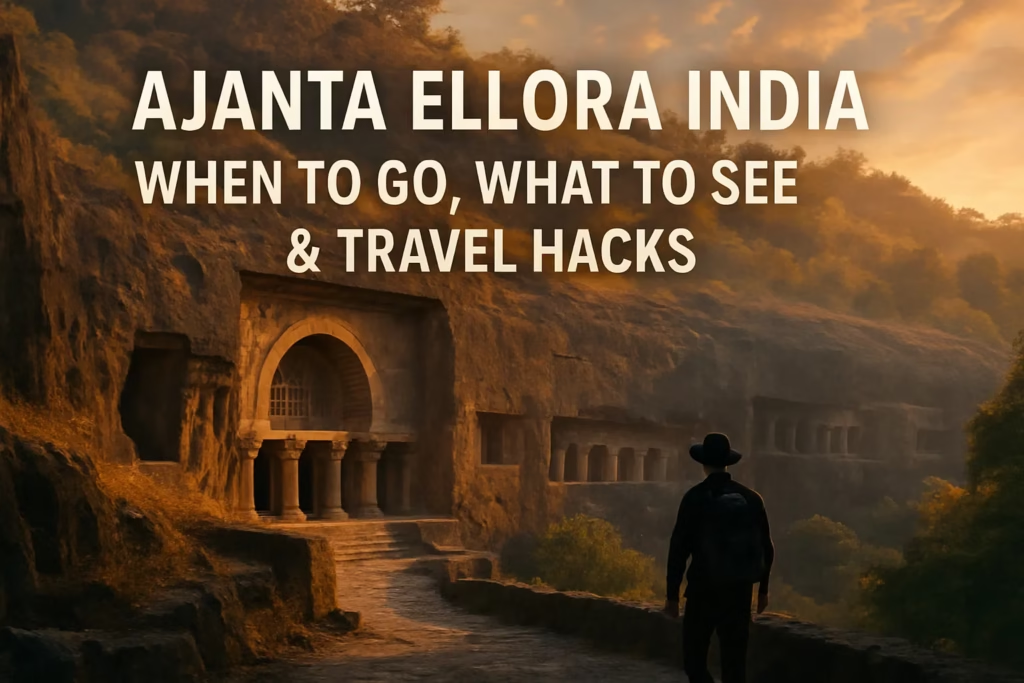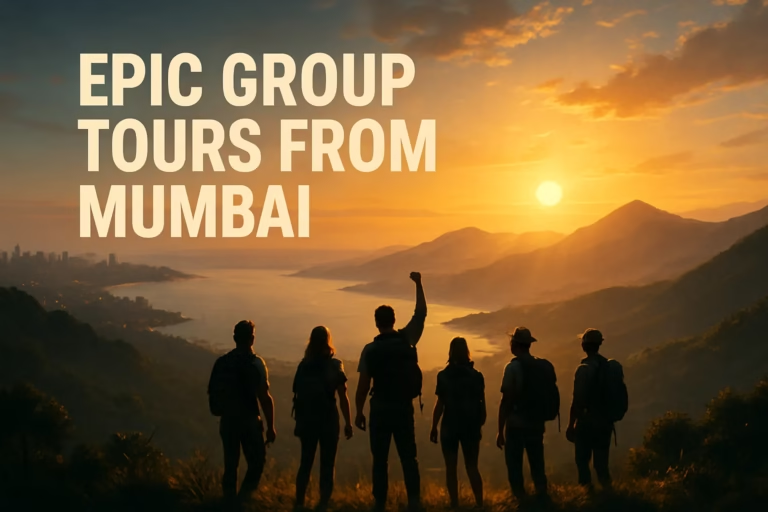Introduction
Everyone overthinks Ajanta Ellora India. They are simpler than you think. The caves stand quiet in the rocky outcrops near Aurangabad, waiting for anyone who values timing and pacing more than fancy gear. The real trick is choosing when to go and how to move through the site without racing through centuries of art and architecture.
In what follows, you will find practical guidance on the best season to visit, the must-see caves at both Ajanta and Ellora, on-the-ground tweaks for a smoother visit, reliable logistics, and simple itineraries. No hype. Just clarity.
1. Best Time to Visit Ajanta & Ellora
1.1 Why Winter Wins
Winter is the clear winner for visiting Ajanta and Ellora. From October to February, temperatures hover between 14 °C and 28 °C. Cool mornings and pleasant afternoons make it easier to walk the trails and linger at the cave façades. In April and May, heat can soar above 40 °C, turning a simple visit into a test of endurance.
The monsoon months, from June to September, bring lush greenery to the Western Ghats. Rain can enhance the landscape, but it also turns paths slippery and often forces partial closures of the caves. The trade-off is clear: green hills at the cost of access and safety.
One winter morning in December, I watched sunlight slice through the entrance of Cave 1 at Ajanta. The soft glow brought the Padmapani fresco to life. That light is worth planning your trip around.
For a detailed month-by-month breakdown, see this best time to visit guide.
1.2 Morning & Evening Windows
The single best way to avoid crowds is to start at first light and linger at dusk. Gates open around sunrise. Enter the site within the first hour, and you may have entire cave façades to yourself. By noon, tour buses arrive and photo opportunities become scarce.
Experienced travellers carve out quiet hours by pausing for mid-morning tea in the village café or slipping back to the hotel for a brief rest. Then they return for a late afternoon session, when the colors of the frescoes deepen and the crowds begin to thin.
2. Must-See Highlights
2.1 Ajanta Cave Essentials
The horseshoe-shaped ravine of Ajanta holds 30 caves dating from the 2nd century BCE to the 7th century CE. It could overwhelm you, but you only need a few stop points. Cave 1 is the entrance to the Ajanta experience. The Padmapani fresco depicting the Bodhisattva of compassion is unimprovable in scale and serenity. Look closely at the lotus. It seems to float.
Caves 16 and 17 are about storytelling. The Jataka tales unwrap before you in narrative panels. Notice how the compositions guide your eye. They are early examples of comic panels in stone and pigment.
Save Cave 26 for a final impression. The reclining Buddha is carved into the rock face, a serene figure amid mythic scenes of temptation by Mara. The sculptures stretch over two stories, revealing the ambition of ancient artisans.
See visitor reviews and photos on Tripadvisor for up-to-date tips.
2.2 Ellora’s Trio of Traditions
Ellora flips the script from Buddhist to Hindu to Jain in a linear sequence of caves carved between the 6th and 11th centuries CE. Cave 16, the Kailasa Temple, is a single-rock marvel. Imagine subtracting 200,000 tonnes of basalt to reveal a chariot-shaped temple. That level of subtraction is its own statement about faith and craftsmanship.
The Hindu galleries—Caves 13 to 29—are carved with myths of Shiva, Vishnu, and Durga. Take time to follow the panels in Caves 15 and 21. They read like stone-bound storybooks. Then move to the Jain sanctums, Caves 30 to 34, where the carvings feel lighter, more intricate. The Tirthankaras appear in microcosm, each detail precise.
One quick tip: if you stay for the evening Sound & Light show, resist the dramatics. Focus on the narration of the stories and the way shadows play across the carvings. The show can feel touristy, but the underlying history remains potent.
3. Travel Hacks & On-Site Tips
3.1 Crowd-Avoidance Strategies
Visiting in the off-peak months of October, November, or late February reduces the number of day-trippers. If you can manage a weekday visit, even better. Aim for Tuesday through Friday. Ajanta is closed on Mondays and Ellora on Tuesdays. That natural closure day gives you a buffer against weekend crowds.
For the earliest entry, buy your ticket at the on-site counter the day before and ask about first-light access. You set your alarm, not your expectations. It does not guarantee solitude, but it gets you in before most groups.
3.2 Gear & Prep
Your packing list for Ajanta Ellora India can be minimalist. Comfortable footwear is non-negotiable. The trails are uneven and stone steps abound. A refillable water bottle will keep you hydrated without adding plastic to the site.
Light rain gear—think compact rain jacket—can save a morning if a stray monsoon shower appears. Beyond that, travel light: one bag, one phone, one notebook. Leave the drone at home unless you have official permission. The caves reward presence, not gadgets.
3.3 Mindful Exploration
Resist the urge to sprint. Choose one cave complex at a time. Spend at least five minutes in stillness. Close your eyes. Listen to the breeze through the rock shelters. Then open your eyes and look for the less obvious details: a faded line in a fresco, a trace of color in a carving.
Local hosts and guides can share stories you will not find in guidebooks. If you prefer to go solo, use audio guides sparingly. They can disrupt the flow. Pick a guide for a short segment—say, the history of the Kailasa Temple—and then continue on your own.
4. Getting There: Aurangabad to the Caves
For a comprehensive overview of how to reach and what to see, refer to this Ajanta and Ellora travel guide.
4.1 By Road
Private cars or taxis via National Highway 753F are the most flexible options. The drive to Ajanta takes about 2 hours and 20 minutes, costing roughly ₹2,500 for a sedan. To Ellora, the ride is closer to 1.5 hours and may cost around ₹1,200. You control the schedule. You stop for roadside snacks or photo breaks. A fixed bus schedule cannot compete with that kind of freedom.
Alternatively, you can book a guided day trip from Aurangabad via Klook.
4.2 By Public Transport
The Maharashtra State Road Transport Corporation (MSRTC) runs direct buses to both sites. Ajanta buses depart daily at 8:30 AM from Aurangabad Central Bus Stand. The journey takes 2 to 2.5 hours and costs about ₹700. Ellora is served by a similar 8:30 AM departure with a fare around ₹344 and a 1.5-hour run.
You can also book bus tickets online through MakeMyTrip.
Trains run between Aurangabad and Ellora. The ride takes roughly 90 minutes. Tickets start at ₹50 for unreserved seating. Check schedules ahead of time. Trains are less frequent than buses and may not align with early-morning cave visits.
| Mode | Departure | Duration | Cost (INR) |
|---|---|---|---|
| Private Car/Taxi | Flexible | Ajanta: 2h 20m Ellora: 1h 30m | ₹2,500 (Ajanta) ₹1,200 (Ellora) |
| MSRTC Bus | 8:30 AM Daily | Ajanta: 2–2.5 h Ellora: 1.5 h | ₹700 (Ajanta) ₹344 (Ellora) |
| Train (Ellora) | Check Schedule | 1.5 h | From ₹50 |
5. Entry Fees, Hours & Booking
Both Ajanta and Ellora charge entry fees and have fixed opening days. Ajanta Caves are open from 9 AM to 5 PM, closed on Mondays. Ellora Caves welcome visitors from 9 AM to 6 PM, closed on Tuesdays. Tickets can be purchased online or on-site. Online booking ensures you skip the queue, but it may not account for seasonal schedule changes. On-site purchase gives you direct confirmation of the current hours and any maintenance closures.
| Site | Entry Fee (Adult) | Hours | Closed |
|---|---|---|---|
| Ajanta | ₹300 (Indian) ₹600 (Foreign) | 9 AM–5 PM | Monday |
| Ellora | ₹200 (Indian) ₹500 (Foreign) | 9 AM–6 PM | Tuesday |
Always check the official archaeology department website for the latest ticket rates and any seasonal advisories.
6. Sample Itineraries
6.1 One-Day Sprint
This itinerary demands an early start but covers both sites in a single day. Begin at 6 AM at Ajanta. Spend three hours exploring Caves 1, 16–17, and 26. Depart by 9:30 AM and head to Ellora. Arrive by noon. After a quick lunch break near the entrance, devote the afternoon to Cave 16 (Kailasa), sample a few Hindu galleries, and end with a walkthrough of the Jain sanctums. Plan to finish by 4 PM. Drive back to Aurangabad and stop for chai at a highway stall.
6.2 Two-Day Slow Burn
Day 1 is for Ajanta. Start at sunrise to catch the frescoes in dawn light. Move systematically from Cave 1 to Cave 30, pausing for stillness breaks every 30 minutes. Lunch at the village market, then return for a sunset session at Cave 1 to watch the colors shift. Stay overnight in a nearby guesthouse.
Day 2 focuses on Ellora. Begin at 9 AM and spend the morning at Cave 16. After lunch, explore a few Hindu caves and then the Jain section. If time allows, add Daulatabad Fort or Bibi Ka Maqbara for a nearby side trip. Return leisurely to Aurangabad in the early evening.
Conclusion
Visiting Ajanta Ellora India does not have to be complicated. Choose the right season, plan around the light, go slow, and pack light. Focus on moments rather than monuments. A mindful approach reveals the artistry and intent of ancient hands carving into living rock.
Ready to explore with ease? Download the Kozyclan app for curated group journeys that leave out the stress—and include the wonder.
Looking for more travel inspiration? Check out our related articles:


